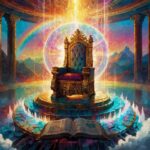The book of Revelation, also known as the Apocalypse, is the final book of the New Testament in the Bible. It is attributed to the Apostle John and is filled with vivid imagery, symbolism, and prophecies about the end times. The book is structured around a series of visions that John received on the island of Patmos, revealing a cosmic conflict between good and evil, the ultimate triumph of God, and the establishment of a new heaven and new earth. Throughout the book, there are references to Old Testament prophecies, as well as themes of judgment, redemption, and the ultimate victory of Christ over evil. The book of Revelation has been a source of fascination and debate for centuries, with interpretations varying widely among scholars and theologians. Despite its complexity, the central message of Revelation is one of hope and assurance for believers, reminding them of the sovereignty of God and the ultimate fulfillment of His purposes in the world.
Book of Revelation
The book of Revelation reveals prophecies about the end times, the victory of Christ, and God's ultimate judgment.

Chapters in Book of Revelation
Summary of the Book of Revelation
F.A.Q. for the Book of Revelation
What is the significance of the 'seven seals' in the book of Revelation?
The ‘seven seals’ in the book of Revelation are described in chapters 5 to 8. They represent a series of divine judgments that are unleashed upon the world as each seal is broken by the Lamb, who is identified as Jesus Christ. The seals include:
- First Seal: A white horse whose rider represents conquest.
- Second Seal: A red horse symbolizing war.
- Third Seal: A black horse representing famine.
- Fourth Seal: A pale horse symbolizing death and Hades.
- Fifth Seal: Reveals the souls of martyrs crying out for justice.
- Sixth Seal: Describes a cosmic disturbance, including a great earthquake
- Seventh Seal: Leads into the trumpet judgments, representing deeper levels of divine intervention.
The sequence of the seven seals reflects the unfolding of divine plans concerning both judgment and redemption, emphasizing the ultimate sovereignty and justice of God.
What is the meaning of the 'New Jerusalem' described in Revelation chapters 21 and 22?
The ‘New Jerusalem’ in Revelation chapters 21 and 22 symbolizes the final and eternal dwelling place of God with humanity. This city represents the fulfillment of God’s promise to restore and renew creation. Key attributes include:
- Perfect Harmony: The city is characterized by perfect peace, devoid of death, mourning, crying, or pain (Revelation 21:4).
- Divine Presence: God’s presence is fully manifest, symbolizing ultimate communion between God and His people (Revelation 21:3).
- Glorious Light: The city does not need the sun or moon because the glory of God illuminates it, and the Lamb is its lamp (Revelation 21:23).
- Water of Life: A river of the water of life flows from the throne of God and the Lamb, symbolizing eternal life and sustenance (Revelation 22:1-2).
- Healing of Nations: The leaves of the tree of life are for the healing of the nations, indicating the restoration of creation and the reconciliation of humanity (Revelation 22:2).
The New Jerusalem represents the consummation of God’s redemptive plan, where heaven and earth are united, and righteousness dwells eternally.
Who are the 'Four Horsemen of the Apocalypse' in Revelation, and what do they represent?
The ‘Four Horsemen of the Apocalypse’ are introduced with the opening of the first four seals in Revelation chapter 6. Each horse and rider symbolizes different aspects of judgment:
- First Horseman (White Horse): Often interpreted as representing conquest or the Antichrist. The rider holds a bow and is given a crown, symbolizing victory and dominion (Revelation 6:2).
- Second Horseman (Red Horse): Symbolizes warfare and bloodshed. The rider is granted power to take peace from the earth and wields a large sword, signifying violent conflict (Revelation 6:4).
- Third Horseman (Black Horse): Represents famine and economic disparity. The rider holds a pair of scales, indicating a measure of scarcity and the careful weighing of resources (Revelation 6:5-6).
- Fourth Horseman (Pale Horse): Associated with death and Hades. The rider is named Death, and Hades follows closely, symbolizing widespread mortality from sword, famine, plague, and wild beasts (Revelation 6:8).
These horsemen collectively represent the various calamities that befall humanity as part of divine judgment, illustrating the severity and totality of the challenges preceding the end times and ultimate redemption.